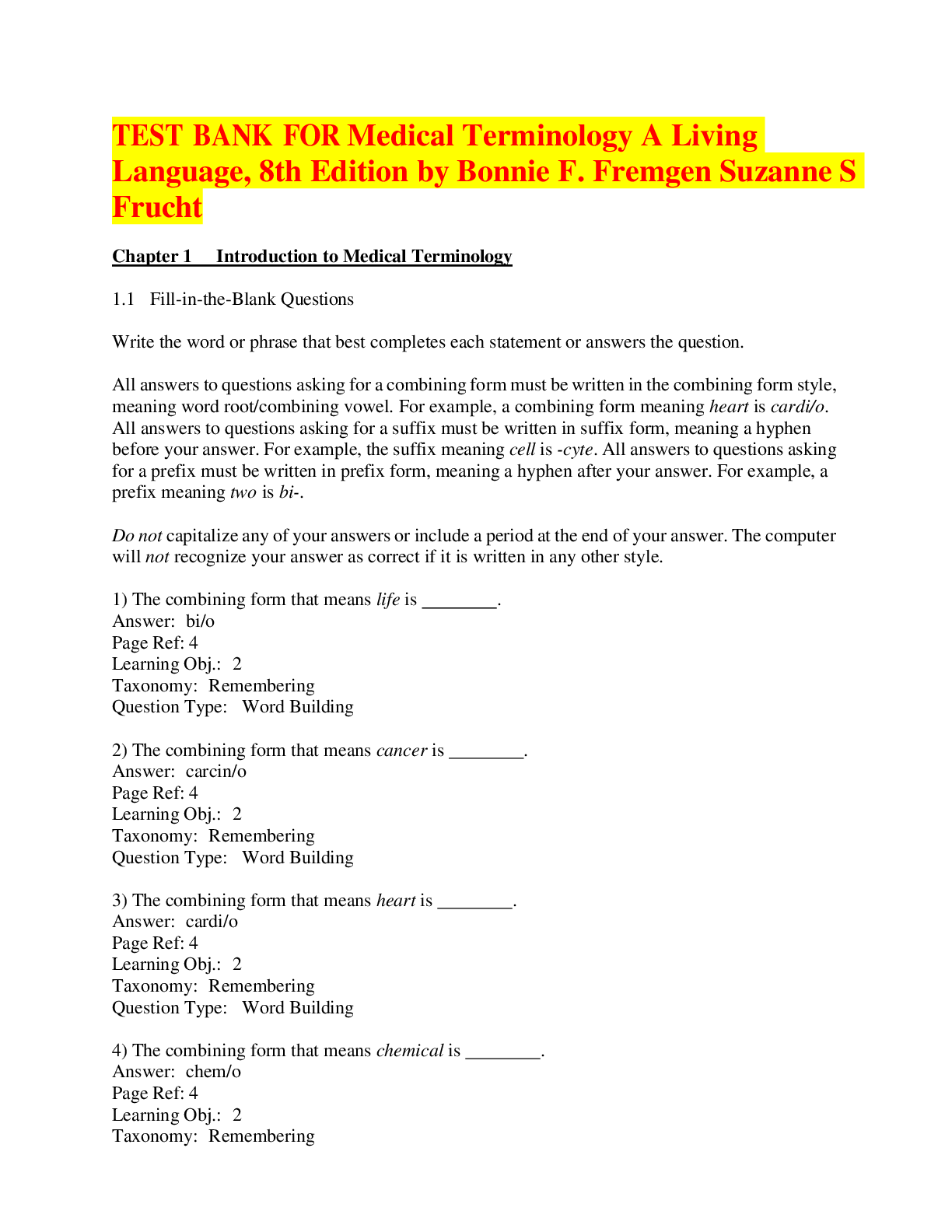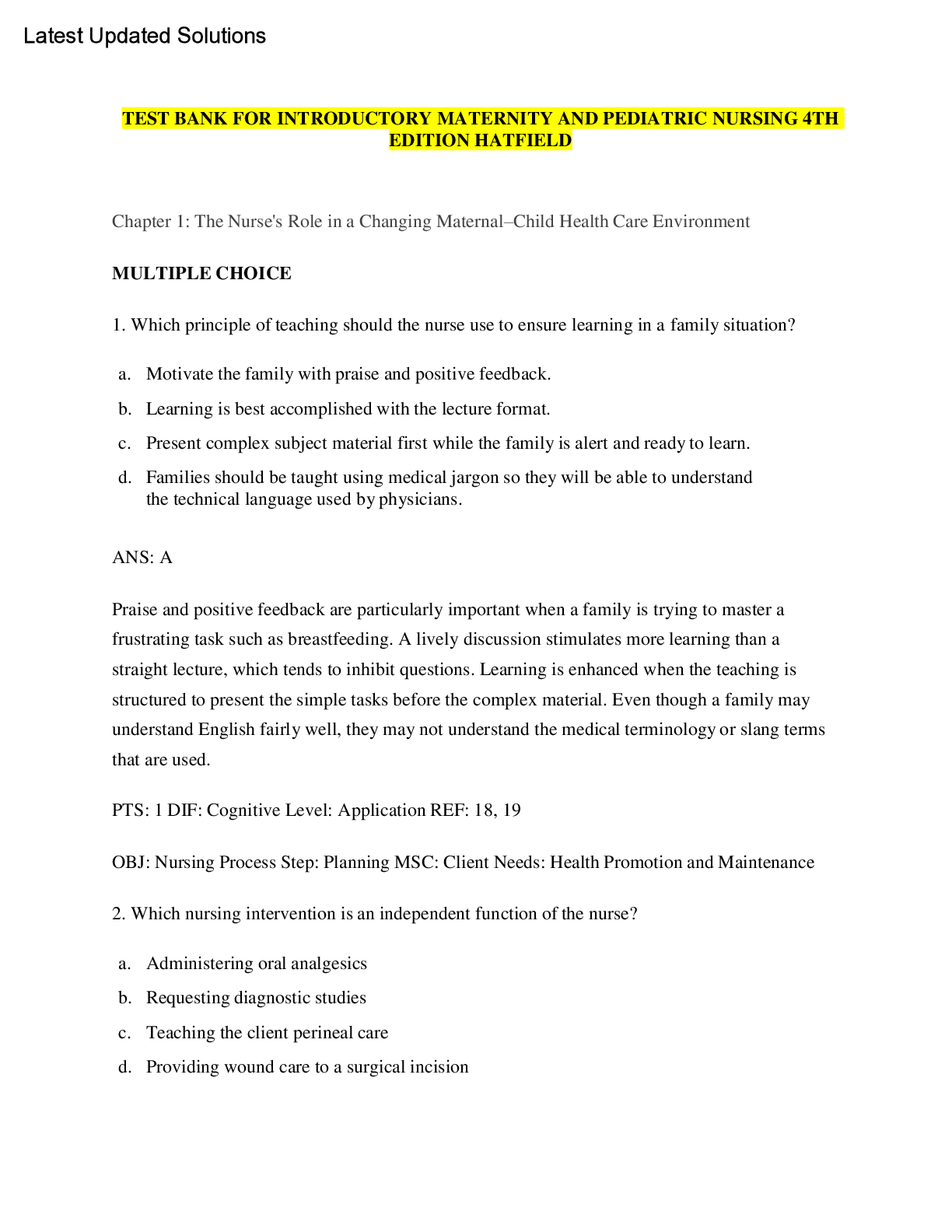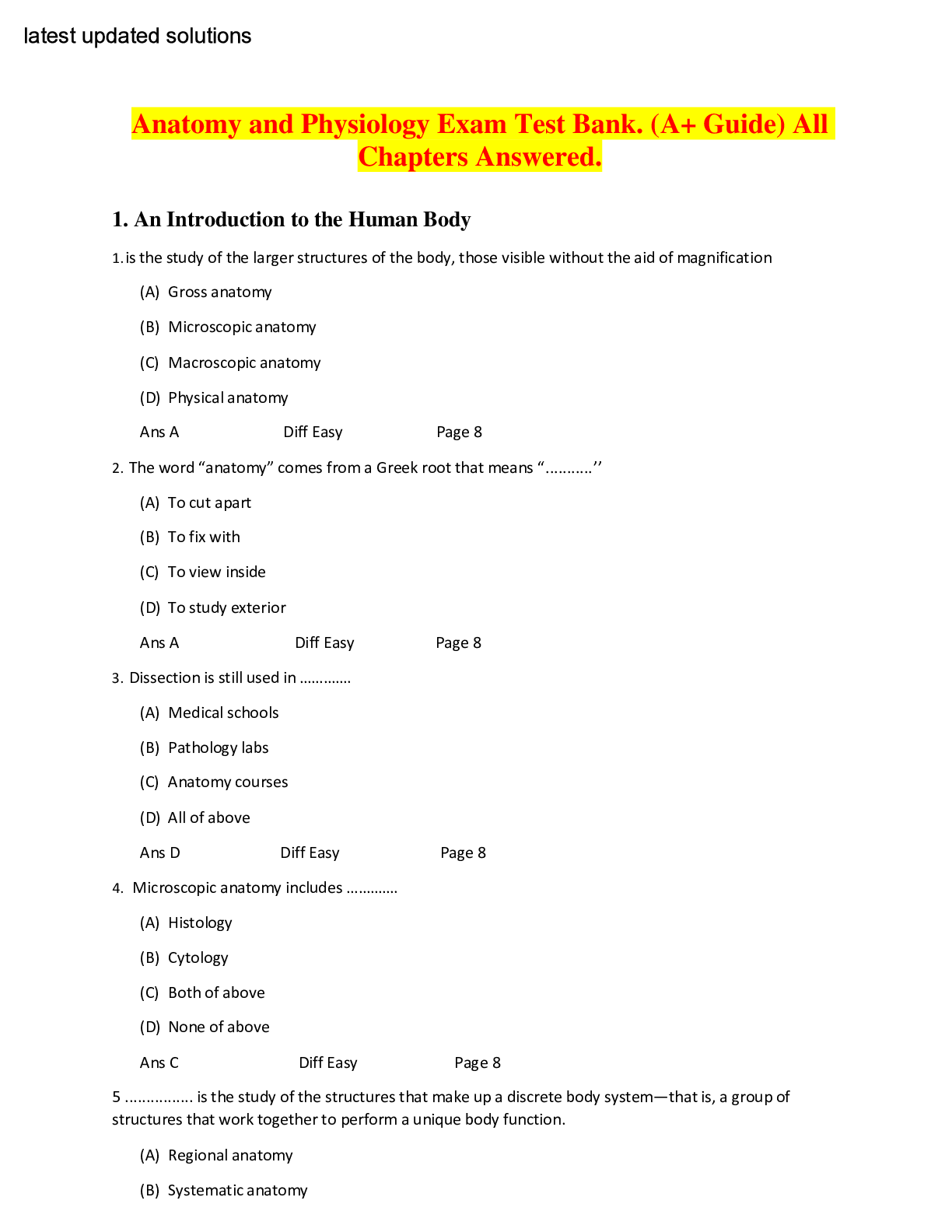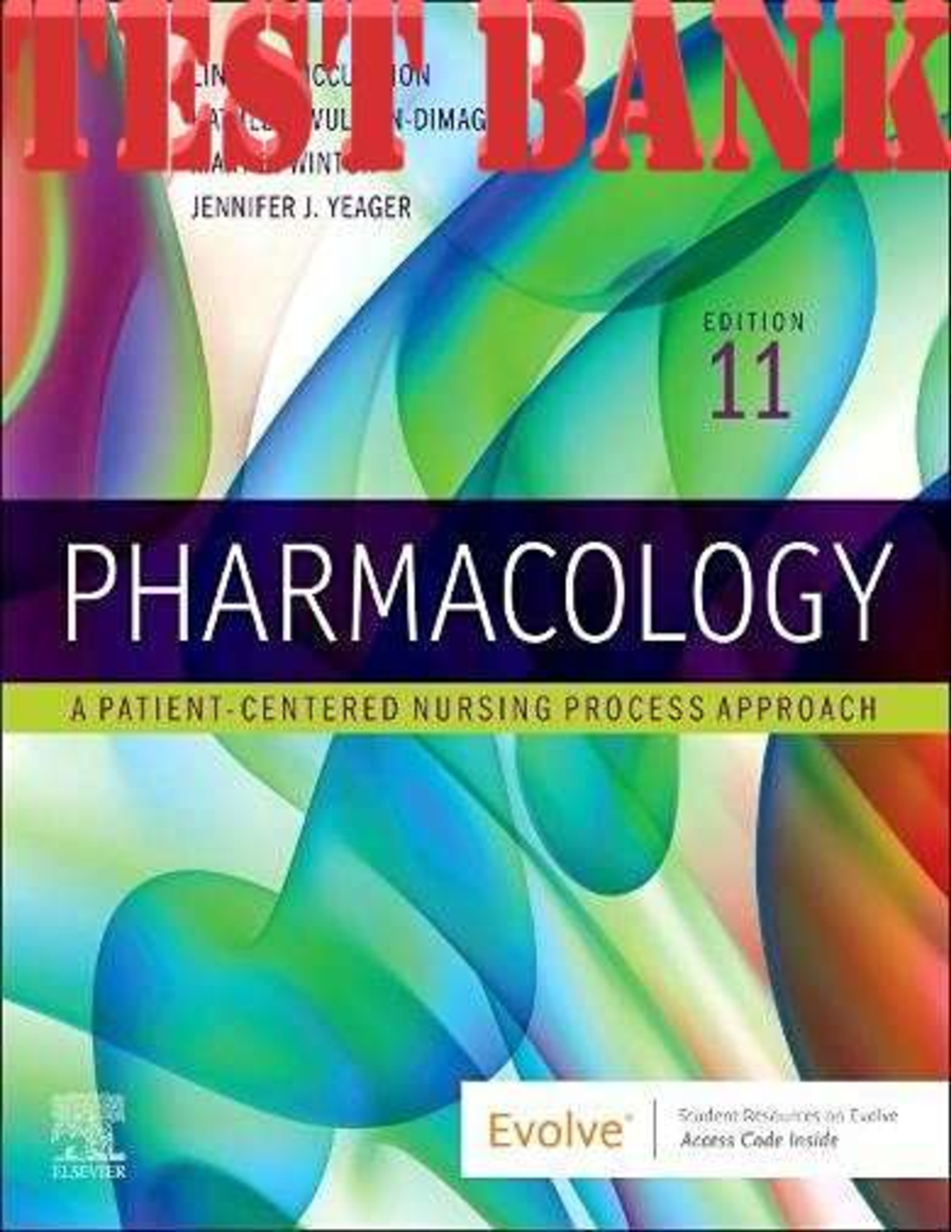healthcare > TEST BANKS > Test Bank For Health, Safety, and Nutrition for the Young Child, 11th Edition by Lynn R. Marotz (All)
Test Bank For Health, Safety, and Nutrition for the Young Child, 11th Edition by Lynn R. Marotz
Document Content and Description Below
Test Bank For Health, Safety, and Nutrition for the Young Child, 11th Edition by Lynn R. Marotz-1. Health is primarily a state of physical well-being. a. True b. False ANSWER: False RATIONALE: A p... erson's state of health involves more than physical well-being. Health encompasses physical, emotional, social, economic, cultural, and spiritual wellness. POINTS: 1 DIFFICULTY: Easy REFERENCES: Health, Safety, and Nutrition: An Interdependent Relationship QUESTION TYPE: True / False HAS VARIABLES: False LEARNING OBJECTIVES: HSN.MARO.11.01.02 - Explain how health, safety, and nutrition are interrelated and discuss factors that influence the quality of each. NATIONAL STANDARDS: United States - NAEYC 1 - Child development and learning in context. United States - NHES 1 - Students will comprehend concepts related to health promotion and disease prevention to enhance health. KEYWORDS: Bloom’s: Understand 2. Current definitions of health recognize that individuals must take a proactive role in reducing their risk of chronic disease. a. True b. False ANSWER: True RATIONALE: An individual’s lifestyle choices have a significant immediate and long-term effect on their health and potential development of chronic diseases. POINTS: 1 DIFFICULTY: Moderate REFERENCES: The Preventive Health Concept QUESTION TYPE: True / False HAS VARIABLES: False LEARNING OBJECTIVES: HSN.MARO.11.01.01 - Define the preventive health concept and describe several national programs that address children’s health needs. NATIONAL STANDARDS: United States - NAEYC 1 - Child development and learning in context. United States - NHES 1 - Students will comprehend concepts related to health promotion and disease prevention to enhance health. KEYWORDS: Bloom’s: Understand 3. A teacher’s knowledge of developmental norms plays an important role in the prevention of children’s unintentional injuries. a. True Page 2 b. False ANSWER: True RATIONALE: Teachers create safe learning activities and environments when they understand children's typical skills and abilities at a given age. POINTS: 1 DIFFICULTY: Moderate REFERENCES: Health, Safety, and Nutrition: An Interdependent Relationship QUESTION TYPE: True / False HAS VARIABLES: False LEARNING OBJECTIVES: HSN.MARO.11.01.04 - Discuss ways that teachers can be proactive in promoting children’s wellness in the areas of injury prevention, oral health, physical activity, and mental health. NATIONAL STANDARDS: United States - NAEYC 1 - Child development and learning in context. United States - NHES 1 - Students will comprehend concepts related to health promotion and disease prevention to enhance health. KEYWORDS: Bloom’s: Understand 4. During the first six months, an infant can be expected to grow almost one inch in length per month. a. True b. False ANSWER: True RATIONALE: An infant's birth length increases by approximately 50 percent during the first year. The most rapid growth occurs during the first 6 months. POINTS: 1 DIFFICULTY: Moderate REFERENCES: Children’s Growth and Development QUESTION TYPE: True / False HAS VARIABLES: False LEARNING OBJECTIVES: HSN.MARO.11.01.03 - Describe typical growth and developmental characteristics of infants, toddlers, preschool-age, and school-age children. NATIONAL STANDARDS: United States - NAEYC 1 - Child development and learning in context. United States - NHES 1 - Students will comprehend concepts related to health promotion and disease prevention to enhance health. KEYWORDS: Bloom's: Remember 5. Two-year-olds can be expected to play cooperatively with one another. a. True b. False ANSWER: False RATIONALE: Most toddlers play by themselves (solitary play) and engage in onlooker (watching what other children are doing) and parallel (playing side-by-side but not together) play. Young children do not typically begin to play together cooperatively until age three or four. POINTS: 1 DIFFICULTY: Moderate REFERENCES: Children’s Growth and Development QUESTION TYPE: True / False HAS VARIABLES: False Page 3 LEARNING OBJECTIVES: HSN.MARO.11.01.03 - Describe typical growth and developmental characteristics of infants, toddlers, preschool-age, and school-age children. NATIONAL STANDARDS: United States - NAEYC 1 - Child development and learning in context. United States - NHES 1 - Students will comprehend concepts related to health promotion and disease prevention to enhance health. KEYWORDS: Bloom’s: Understand 6. Norms are skills that children should be able to demonstrate at a specific age. a. True b. False ANSWER: False RATIONALE: Developmental norms identify milestones when the majority of children are able to perform a given skill. There is a wide range of normalcy....some children will demonstrate the skill earlier than this and some will do so later. POINTS: 1 DIFFICULTY: Moderate REFERENCES: Children’s Growth and Development QUESTION TYPE: True / False HAS VARIABLES: False LEARNING OBJECTIVES: HSN.MARO.11.01.03 - Describe typical growth and developmental characteristics of infants, toddlers, preschool-age, and school-age children. NATIONAL STANDARDS: United States - NAEYC 1 - Child development and learning in context. United States - NHES 2 - Students will analyze the influence of family, peers, culture, media, technology, and other factors on health behavior. KEYWORDS: Bloom’s: Remember 7. Oral hygiene practices should be implemented as soon as a child’s permanent teeth have erupted. a. True b. False ANSWER: False RATIONALE: Oral hygiene practices should be initiated during early infancy and continued forever. Tooth buds are present in the infant's gums and must be cared for by wiping (the gums) after each feeding to prevent cavity formation. POINTS: 1 DIFFICULTY: Easy REFERENCES: Promoting a Healthy Lifestyle QUESTION TYPE: True / False HAS VARIABLES: False LEARNING OBJECTIVES: HSN.MARO.11.01.04 - Discuss ways that teachers can be proactive in promoting children’s wellness in the areas of injury prevention, oral health, physical activity, and mental health. NATIONAL STANDARDS: United States - NAEYC 1 - Child development and learning in context. United States - NHES 2 - Students will analyze the influence of family, peers, culture, media, technology, and other factors on health behavior. KEYWORDS: Bloom’s: Understand 8. Children’s social-emotional competence can have a direct effect on their state of well-being. a. True Page 4 b. False ANSWER: True RATIONALE: Social-emotional competence affects all dimensions of health, including physical, spiritual, cultural, etc. POINTS: 1 DIFFICULTY: Moderate REFERENCES: Promoting a Healthy Lifestyle QUESTION TYPE: True / False HAS VARIABLES: False LEARNING OBJECTIVES: HSN.MARO.11.01.04 - Discuss ways that teachers can be proactive in promoting children’s wellness in the areas of injury prevention, oral health, physical activity, and mental health. NATIONAL STANDARDS: United States - NAEYC 1 - Child development and learning in context. United States - NHES 2 - Students will analyze the influence of family, peers, culture, media, technology, and other factors on health behavior. KEYWORDS: Bloom’s: Understand 9. The Whole School, Whole Community, Whole Child model establishes health and safety regulations that schools must follow. a. True b. False ANSWER: False RATIONALE: The Whole School, Whole Community, Whole Child model acknowledges the critical effect that children's health has on learning. The plan assumes an ecological approach and encourages collaboration among schools, families, agencies, and community partners in meeting children's health, safety, and academic needs to promote learning. POINTS: 1 DIFFICULTY: Moderate REFERENCES: The Preventive Health Concept QUESTION TYPE: True / False HAS VARIABLES: False LEARNING OBJECTIVES: HSN.MARO.11.01.01 - Define the preventive health concept and describe several national programs that address children’s health needs. NATIONAL STANDARDS: United States - NAEYC 2 - Family-teacher partnerships and community connections United States - NHES 2 - Students will analyze the influence of family, peers, culture, media, technology, and other factors on health behavior. KEYWORDS: Bloom’s: Remember 10. A child who suffers from depression may be indecisive, exhibit uncontrollable anger, and/or have difficulty sleeping. a. True b. False ANSWER: True RATIONALE: These behaviors are common signs of childhood depression. Additional signs may include apathy, loss of appetite, frequent complaints of illness, and poor self-esteem. POINTS: 1 DIFFICULTY: Moderate REFERENCES: Promoting a Healthy Lifestyle [Show More]
Last updated: 5 months ago
Preview 5 out of 302 pages

Loading document previews ...
Buy this document to get the full access instantly
Instant Download Access after purchase
Buy NowInstant download
We Accept:

Reviews( 0 )
$17.50
Can't find what you want? Try our AI powered Search
Document information
Connected school, study & course
About the document
Uploaded On
Feb 02, 2025
Number of pages
302
Written in
Additional information
This document has been written for:
Uploaded
Feb 02, 2025
Downloads
0
Views
15






_compressed.png)
.png)
.png)


.png)













